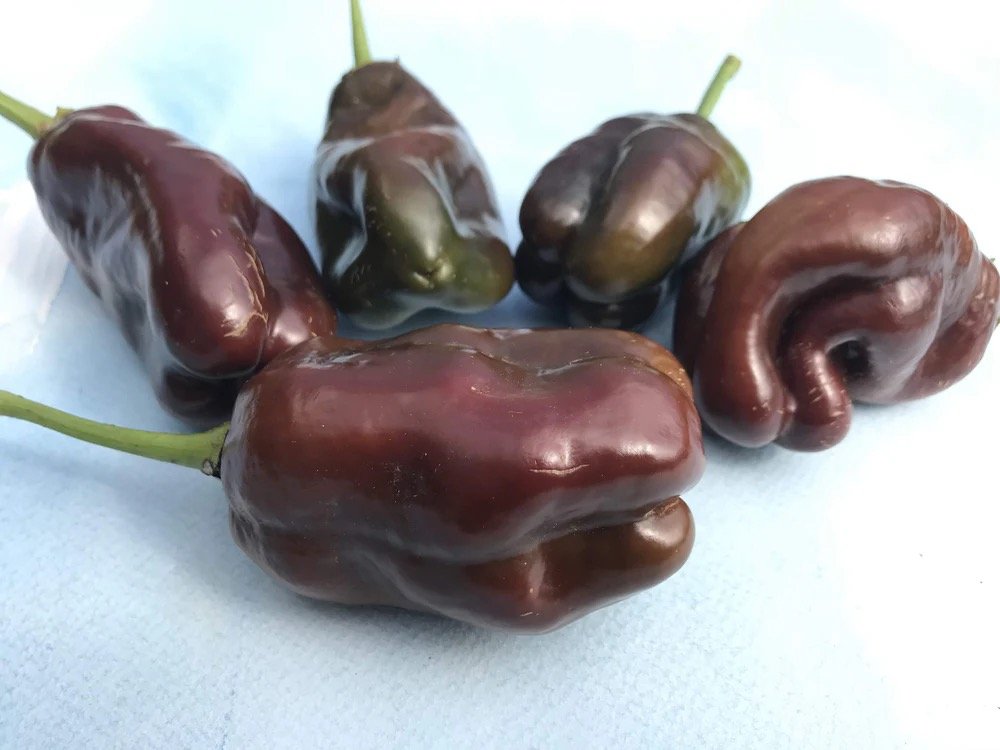 Image 1 of 2
Image 1 of 2

 Image 2 of 2
Image 2 of 2



Sweet Chocolate Pepper
From Hudson Valley Seed Company. Purchased in 2023.
Description and growing instructions below from Hudson Valley Seeds.
A chocolate colored sweet bell pepper.
Medium-sized, elongated, thick-walled fruit bear the color of chocolate as they ripen; they acquire a scarlet hue when fully ripe. Fruit are abundant on plants that are medium-tall in height. Flavor is sweet and texture is crunchy but, alas, they do not taste like chocolate. An excellent slicing pepper for salads, where its unique color creates plenty of interest.
GROWING INSTRUCTIONS.
Pepper seed requires heat to germinate; it just won't do much in cool soil. So the first trick is to find a spot that is steadily warm; usinag a heat mat is ideal, but above the fridge may work, as might a spot near the woodstove. Sow pepper seeds at least 6-8 weeks before your last frost date; they mature later in the season than tomatoes, and to get a good crop of ripe peppers requires an early start. (If you prefer green peppers, you've got more flexibility.) Sow peppers about a quarter-inch deep in soil blocks or plug trays. Give them a good ten to fourteen days to germinate before thinking of giving up on them. Once up, peppers grow quite slowly when young and, again, require warmth to grow quickly. Peppers should not be transplanted until the weather is settled, usually about two weeks after tomatoes go in. Space them about 18" apart. Row cover provides a warm microclimate for quicker growth. Although most pepper plants stay much smaller than tomato vines, their stems are weak and, when loaded with fruit, they tend to blow over in late summer storms. They can easily be staked to prevent this.
From Hudson Valley Seed Company. Purchased in 2023.
Description and growing instructions below from Hudson Valley Seeds.
A chocolate colored sweet bell pepper.
Medium-sized, elongated, thick-walled fruit bear the color of chocolate as they ripen; they acquire a scarlet hue when fully ripe. Fruit are abundant on plants that are medium-tall in height. Flavor is sweet and texture is crunchy but, alas, they do not taste like chocolate. An excellent slicing pepper for salads, where its unique color creates plenty of interest.
GROWING INSTRUCTIONS.
Pepper seed requires heat to germinate; it just won't do much in cool soil. So the first trick is to find a spot that is steadily warm; usinag a heat mat is ideal, but above the fridge may work, as might a spot near the woodstove. Sow pepper seeds at least 6-8 weeks before your last frost date; they mature later in the season than tomatoes, and to get a good crop of ripe peppers requires an early start. (If you prefer green peppers, you've got more flexibility.) Sow peppers about a quarter-inch deep in soil blocks or plug trays. Give them a good ten to fourteen days to germinate before thinking of giving up on them. Once up, peppers grow quite slowly when young and, again, require warmth to grow quickly. Peppers should not be transplanted until the weather is settled, usually about two weeks after tomatoes go in. Space them about 18" apart. Row cover provides a warm microclimate for quicker growth. Although most pepper plants stay much smaller than tomato vines, their stems are weak and, when loaded with fruit, they tend to blow over in late summer storms. They can easily be staked to prevent this.
